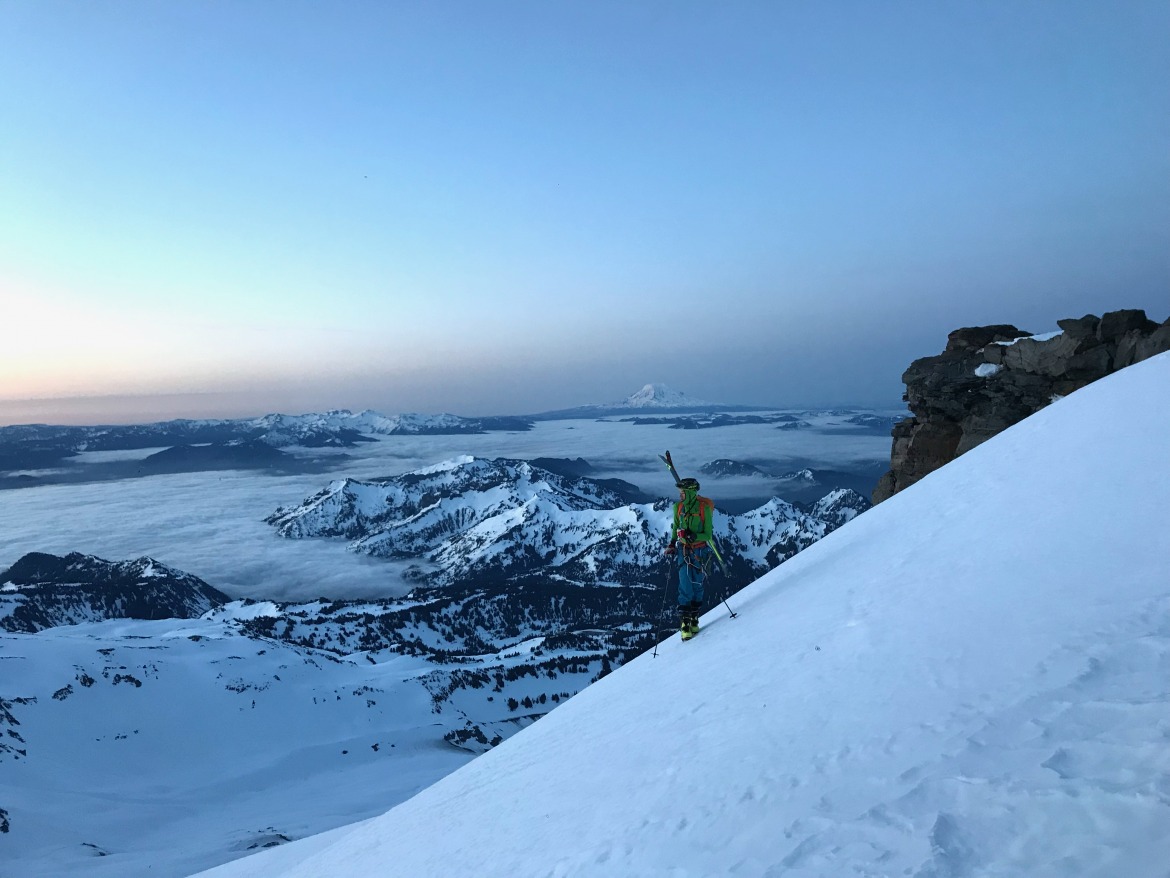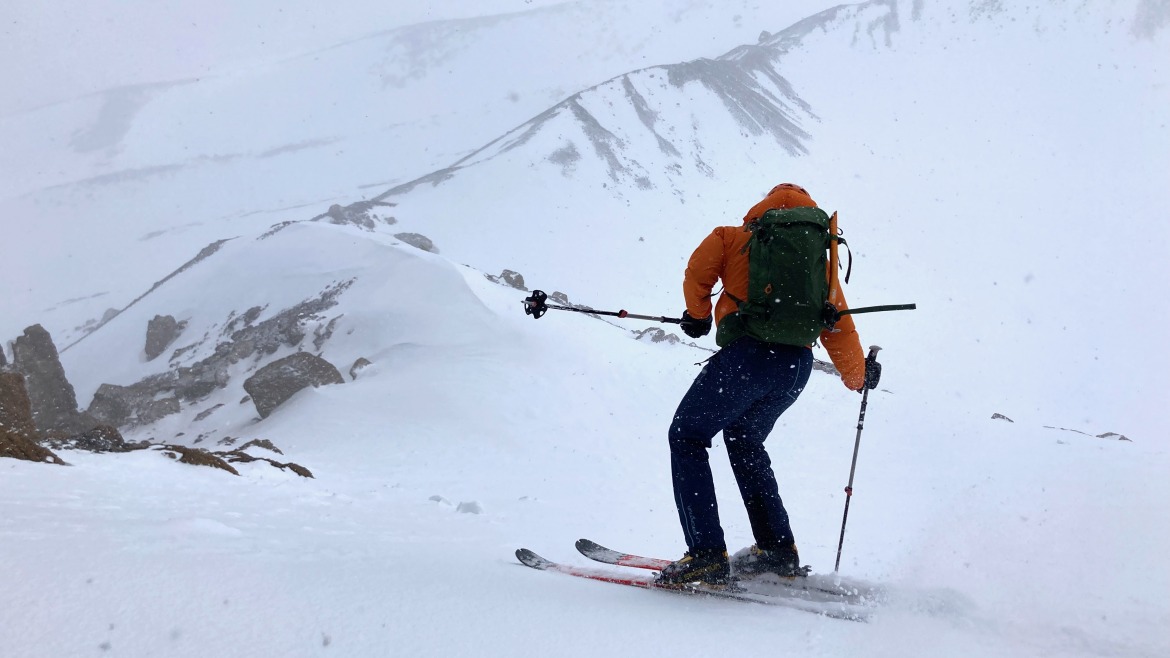
Too long, too short, or just right. Aim for just right when it comes to length of your backcountry ski. For newcomers, find some good advice to lead you down the path of ski-length happiness. In the case above, the skis are on the back for a long haul up Rainier: best to keep the weight down — shorter skis might help with that objective.
It’s just like Goldilocks looking for that ideal porridge; you want your backcountry ski length to be just right. Here are some thoughts for newcomers as they explore skis for the new season and what size they might choose.
Ski manufacturers have to cover costs. The return on investment for selling skis at 1cm or even 2cm length increments is nonsensical. And although each of us is different, it seems the industry has settled into an agreed-upon range for sizing backcountry skis. The days of finding planks punching beyond 190cm in length is rare.
For those just getting started in the backcountry ski realm, it’s good to remember that much of your time is spent skinning uphill on climbing skins. A longer ski, in some instances, can be more challenging to kick turn with, and a longer ski can mean a heavier ski – longer equates to more material, and material has got to weigh something. But on the other hand, shorter might feel great on the skin track but squirrelly and underpowered if making big-fast turns is to your liking. There’s a sweet spot in there somewhere.
The Sizing of the Ski
As a made-to-be-broken rule, a skier’s height is a good starting point for selecting a specific ski length. If you are punching to 6’4″ in height, then a longer ski most often will be in play. If you spot up at 5’4″, then a long ski, something say 175cm and on up, might feel unwieldy on the skin track and descents.
Starting with a ski roughly at head height is an excellent place to start. I’m 5’10”, for example, and most often choose all-around skis in the 175cm range and size up or down depending on the specific tool I’m looking for.
Backcountry ski models often range from 160cm in length up to ~190cm. But, then again, it depends. For more powder-oriented skis, the general lengths often go no shorter than 170cm in men’s specific models. That’s, generally speaking, not a hard and fast rule. For example, the Atomic Backland 107 goes no smaller than 175cm. But if you want something smaller, the even more pow-specific DPS Pagoda Tour 112 RP bumps down to 158cm. DPS keeps their ski lines gender-neutral.
But, if it’s shorter you are looking for, often, you can look at women-specific designs. These skis are usually identical to “men’s” skis; they simply might offer a different topsheet and smaller sizes. Voile’s phat Hyper Drifter women’s sizes are 154cm and 164cm. The men’s model arrives at 171cm, 171cm, and 186cm, respectively. And Atomic makes a women’s model Backland 107 is shorter length too. The point is, if cosmetics don’t matter, you can find what you want.
This piece is for those getting into the backcountry game. Again, we are keeping this simple; very simple. We could go down the rabbit hole of how much rocker a ski has or the sidecut details. But, for now, the variables minimized.
I use the 175cm range as my starting point for more all-around skis. Then I consider where I might use this snow sliding tool. In more open terrain and deeper snow, I’ll go longer. For me, jumping up to a 182cm+ length ski for powder is doable. The longer length offers more surface area (better float) and likely a longer turn radius, which I also prefer. If you like to ski powder in the trees more often than open terrain, then maybe stick with your starting point length (in my case, the ~175cm.) for a more maneuverable ski.
Spring skiing may also mean a different snow sliding tool. With a more pronounced freeze-thaw cycle in spring, you are likely seeking corn snow or steeper, firmer, narrower terrain. As a rule, many go shorter in the spring. I opt for spring skiing skis in the 170-172cm length range. My preferred width underfoot for this time of year is 80-95cm underfoot. No matter, I still opt for a shorter ski.
We all may have different preferences. In spring, the shorter length helps me with more precise jump turns. And if you find yourself in a skinny couloir, the short ski is more maneuverable.
Ski weight is the last factor I consider in spring that pushes me to shorter lengths. More often than not, in spring and into summer, I carry skis on my ski pack. I wouldn’t say I like hauling heavy weights, so I am minimizing ski weight by sizing down. This desire for lower weight also applies to the longer distances I’m likely traveling in spring: this is also the time of year when I’m perhaps attempting a ski traverse or trying to ski a line that requires some mountaineering and plenty of skinning. Again, the shorter ski is often the lighter ski.
(For resort uphilling, I like to apply my norms for spring skiing: Shorter is OK because I’m seeking a lighter ski, not necessarily the best descending ski.)
The 6’4″ child I referenced up top, his “short” spring ski is in the 175cm range, with his longer powder-oriented skis in the 185cm realm.

Find your perfect ski length and find your boogie.
If you have questions about how to size a backcountry touring ski, make sure you consult folks in the know at your local shop (remember, we focused on length almost exclusively here when other factors also help determine how a ski feels and behaves). Our publishing partner Cripple Creek Backcountry can also help set you up if the ski sizing game has you befuddled.
Readers, please chime in on ski sizing so others getting into backcountry skiing can glean some wisdom.
Jason Albert comes to WildSnow from Bend, Oregon. After growing up on the East Coast, he migrated from Montana to Colorado and settled in Oregon. Simple pleasures are quiet and long days touring. His gray hair might stem from his first Grand Traverse in 2000 when rented leather boots and 210cm skis were not the speed weapons he had hoped for. Jason survived the transition from free-heel kool-aid drinker to faster and lighter (think AT), and safer, are better.
